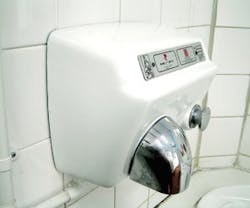Greening a building doesn’t stop at the washroom. In fact, the humble restroom area is rife with opportunities to add to your sustainability efforts. Start greening your facility’s washrooms in four areas: water fixtures, cleaning supplies, personal hygiene products, and the waste stream.
1) Slash Water Use
Older faucets, toilets, and urinals can be incredibly wasteful. Slash water costs dramatically by installing an automated or low-flow solution, which can save around 70% on average, according to Brian Heun, Rubbermaid Commercial Products' product manager for washroom solutions. Touchfree technology further reduces usage by cutting off the water flow when it’s not needed.
“Converting the faucet to an automated faucet is one of the quickest payback periods – typically within 1 to 2 years,” Heun says. “Manual faucets are pretty wasteful in terms of water usage.” If an automated system doesn’t fit the budget this year, retrofitting faucets with aerators will also lower the demand for water.
Switching to waterless urinals completely eliminates the gallon of water used to flush a standard urinal, though some can’t tolerate cleaning chemicals poured down the drain – they can destroy the cleaning cartridge inside.
2) Clean with Green
Approach restroom cleaning from two angles – green replacements for cleaning chemicals and more eco-friendly equipment. Ideally, these go hand-in-hand – “You can pick a green product, and you can utilize equipment that helps you use less of the product,” says Ying Zhang, Rubbermaid’s senior project manager for hard surface cleaning.
Automatic cleaning systems for toilets and urinals use super-concentrated chemicals to sanitize fixtures. There’s no need to measure each chemical, and the automation saves labor.
For floors, microfiber mops last much longer than string mops, Zhang says. A mop bucket with a built-in filter will remove particulates (but not cleaning solutions) from the water, leaving you with a fresh bucket of water without having to refill as often. Adding a wringer lets you keep processing and reusing the mop.
“Typically, the cleaning staff goes to restrooms, and they mop with one bucket of water for 3 bathrooms, go back to the janitor’s closet, dump all the water and chemicals, and refill the bucket with clean water,” Zhang says. “You waste a lot of water and chemicals.”
3) Offer Eco-Friendly Hygiene Products
No green washroom is truly complete without eco-friendly offerings for guests, says Victoria Ciupak, Rubbermaid’s senior product manager of skin care. “A miss is often the soap,” she explains. “You may see a touch-free washroom with everything except the soap upgraded. Having the right sealed, hygienic soap system with green-certified formulas is a simple way to be greener without adding cost.”
Pair a green soap with an automatic or touchfree dispenser for less waste, Heun adds.
“There’s a lot of wasted soap because they’ll have to clean it out or flush it every once in a while, so you just end up pouring the soap down the drain,” Heun says of bulk soap dispensers.
4) Shrink the Waste Stream
Finish off your newly greened sink area with environmentally friendly drying supplies for maximum energy savings and reduced paper waste. Touchless systems minimize cross-contamination, leading to cleaner facilities.
To reduce waste, a hands-free towel dispenser with a motion-activated sensor dispenses one towel at a time. The recently introduced Nvi by Oasis Brands, designed for users with a limited range of mobility, accomplishes the same task with toilet paper.
Hand dryers eliminate paper towels entirely, but consume electricity, requiring a close comparison of operating costs, the product’s green qualities, and other factors. According to the USGBC course Next Generation Green Restroom Design, traditional standard dryers need about 35-45 seconds to dry hands completely, whereas paper towels cut that time down to about 10 seconds. This gap has historically kept hand dryer installation down to about 10% of restrooms.
But the operating cost of the high-speed hand dryer is nearly one-third of its nearest competitor, standard dryers, making it an attractive option for owners seeking to eliminate paper towels altogether.
“It just so happens that the greener you get, the more money you’re going to save,” says Bill Gagnon, vice president of marketing and key accounts for Excel Dryer. “You don’t have to go high-tech to save money. In the restroom, there’s not as much of a cost premium on the green products.”
Janelle Penny ([email protected]) is associate editor of BUILDINGS.
About the Author
Janelle Penny
Editor-in-Chief at BUILDINGS
Janelle Penny has been with BUILDINGS since 2010. She is a two-time FOLIO: Eddie award winner who aims to deliver practical, actionable content for building owners and facilities professionals.

